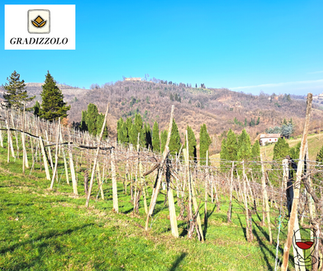Meet the producer: Gradizzolo
- Filippo Manaresi
- Mar 16, 2023
- 3 min read
Over five generations of winemakers have been running this historic winery, which already existed in the early twentieth century.
It has always been family owned and still is. Everyone in the family is involved: from Antonio, who mainly takes care of the vineyard and the cellar with his son Gianluca, to Marisa and Chiara, more inclined to be in the kitchen of the agritourism.
In fact, the choice Antonio made right from the start was to make this company a kind of living organism, where every part is indispensable. The family business is not a succession from above, but a shared choice that is carried out together, amidst difficulties, joys and quarrels, but each one counts as much as the other, and is an integral part of it. In 2008 the farmhouse was opened: wine, of course, but also cooking, hospitality, conviviality, long evenings with friends. There are about a hundred olive trees for the production of oil, alongside fruit trees and a small vegetable garden where the vegetables that are used in the kitchen grow. Together with wild herbs, always present in the peasant tradition.
In 1973 Antonio took over from his father, immediately giving an imprint that respected the environment and the local wine tradition, part of which was being lost.
The company cultivates Pignoletto (Grechetto gentile), Barbera, Negrettino and Alionza.
The latter two are less well-known native varieties, because they fell into disuse after the "invasion" of international grapes and because of some difficulties in their cultivation.
Negrettino: the historical partner of Barbera in the red of Bologna. Gradizzolo produces wine from 100% negretto grapes.
Alionza: it is a perfect white grape for sparkling wine, due to its good acidity.
Barbera: It is a widespread grape throughout northern Italy, but here we have a local variety, different, for example, from the Piedmontese one. The first evidence of the presence of Barbera grapes on the Bologna hills dates back to 1243. Surely one of its main characteristics is acidity; here in the Bolognese area it has always been used also in a sparkling version in perfect combination with the local cuisine. In the still version it is very long-lived, structured, often with good gradations.
Pignoletto: it is the grape of the Bolognese hills, without a doubt. Evidence of its presence dates back to a few millennia ago, and it is making itself known even beyond national borders. It is vinified both in still and sparkling versions, refermented in the bottle or macerated in amphorae.
During the visit, I had the chance to taste some of the excellent wines of the winery.
Bersot Pignoletto fermo 2021: 100% pignoletto grapes from a 1933 vineyard, naturally fermented and elevated in steel vats, unfiltered. Yellow plum fennel, good flavour, sapid and fresh.
Le Anfore 2021: 100% pignoletto grapes, naturally fermented and elevated in terracotta amphoras, unfiltered. Three months of skin contact maceration, one year ageing in amphora. An orange wine with an opulent nose of nail polish, honey, saffron, plums, apricot. Very typical hints of fennel and dill. Medium body, agile and tense, acid and balanced, slightly tannic and mineral. Beautiful bitter and long finish.
Barbera Bricco dell'Invernata 2020: 100% Barbera, naturally fermented and elevated in steel and concrete vats. Red fruits and bitter freshness. Very classic Barbera, not particularly acidic and edgy, lively but at the same time soft.
The wine estate is open to visitors, for more info:
Via Invernata, 2, 40050 Monteveglio (Bologna), Italy
Tel: (+39) 331 730 0553

















Comments